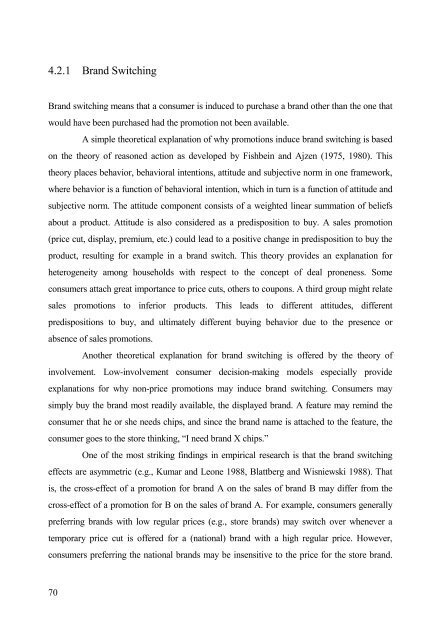Analysis of Sales Promotion Effects on Household Purchase Behavior
Analysis of Sales Promotion Effects on Household Purchase Behavior
Analysis of Sales Promotion Effects on Household Purchase Behavior
Create successful ePaper yourself
Turn your PDF publications into a flip-book with our unique Google optimized e-Paper software.
4.2.1 Brand Switching<br />
Brand switching means that a c<strong>on</strong>sumer is induced to purchase a brand other than the <strong>on</strong>e that<br />
would have been purchased had the promoti<strong>on</strong> not been available.<br />
A simple theoretical explanati<strong>on</strong> <str<strong>on</strong>g>of</str<strong>on</strong>g> why promoti<strong>on</strong>s induce brand switching is based<br />
<strong>on</strong> the theory <str<strong>on</strong>g>of</str<strong>on</strong>g> reas<strong>on</strong>ed acti<strong>on</strong> as developed by Fishbein and Ajzen (1975, 1980). This<br />
theory places behavior, behavioral intenti<strong>on</strong>s, attitude and subjective norm in <strong>on</strong>e framework,<br />
where behavior is a functi<strong>on</strong> <str<strong>on</strong>g>of</str<strong>on</strong>g> behavioral intenti<strong>on</strong>, which in turn is a functi<strong>on</strong> <str<strong>on</strong>g>of</str<strong>on</strong>g> attitude and<br />
subjective norm. The attitude comp<strong>on</strong>ent c<strong>on</strong>sists <str<strong>on</strong>g>of</str<strong>on</strong>g> a weighted linear summati<strong>on</strong> <str<strong>on</strong>g>of</str<strong>on</strong>g> beliefs<br />
about a product. Attitude is also c<strong>on</strong>sidered as a predispositi<strong>on</strong> to buy. A sales promoti<strong>on</strong><br />
(price cut, display, premium, etc.) could lead to a positive change in predispositi<strong>on</strong> to buy the<br />
product, resulting for example in a brand switch. This theory provides an explanati<strong>on</strong> for<br />
heterogeneity am<strong>on</strong>g households with respect to the c<strong>on</strong>cept <str<strong>on</strong>g>of</str<strong>on</strong>g> deal pr<strong>on</strong>eness. Some<br />
c<strong>on</strong>sumers attach great importance to price cuts, others to coup<strong>on</strong>s. A third group might relate<br />
sales promoti<strong>on</strong>s to inferior products. This leads to different attitudes, different<br />
predispositi<strong>on</strong>s to buy, and ultimately different buying behavior due to the presence or<br />
absence <str<strong>on</strong>g>of</str<strong>on</strong>g> sales promoti<strong>on</strong>s.<br />
Another theoretical explanati<strong>on</strong> for brand switching is <str<strong>on</strong>g>of</str<strong>on</strong>g>fered by the theory <str<strong>on</strong>g>of</str<strong>on</strong>g><br />
involvement. Low-involvement c<strong>on</strong>sumer decisi<strong>on</strong>-making models especially provide<br />
explanati<strong>on</strong>s for why n<strong>on</strong>-price promoti<strong>on</strong>s may induce brand switching. C<strong>on</strong>sumers may<br />
simply buy the brand most readily available, the displayed brand. A feature may remind the<br />
c<strong>on</strong>sumer that he or she needs chips, and since the brand name is attached to the feature, the<br />
c<strong>on</strong>sumer goes to the store thinking, “I need brand X chips.”<br />
One <str<strong>on</strong>g>of</str<strong>on</strong>g> the most striking findings in empirical research is that the brand switching<br />
effects are asymmetric (e.g., Kumar and Le<strong>on</strong>e 1988, Blattberg and Wisniewski 1988). That<br />
is, the cross-effect <str<strong>on</strong>g>of</str<strong>on</strong>g> a promoti<strong>on</strong> for brand A <strong>on</strong> the sales <str<strong>on</strong>g>of</str<strong>on</strong>g> brand B may differ from the<br />
cross-effect <str<strong>on</strong>g>of</str<strong>on</strong>g> a promoti<strong>on</strong> for B <strong>on</strong> the sales <str<strong>on</strong>g>of</str<strong>on</strong>g> brand A. For example, c<strong>on</strong>sumers generally<br />
preferring brands with low regular prices (e.g., store brands) may switch over whenever a<br />
temporary price cut is <str<strong>on</strong>g>of</str<strong>on</strong>g>fered for a (nati<strong>on</strong>al) brand with a high regular price. However,<br />
c<strong>on</strong>sumers preferring the nati<strong>on</strong>al brands may be insensitive to the price for the store brand.<br />
70

















